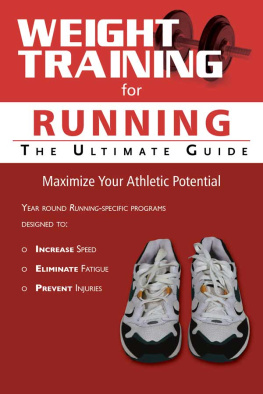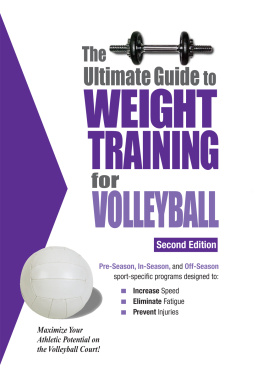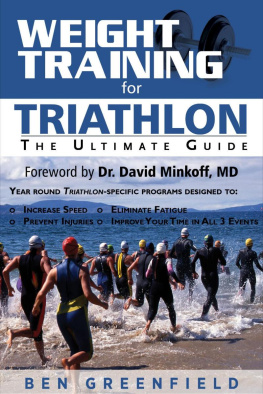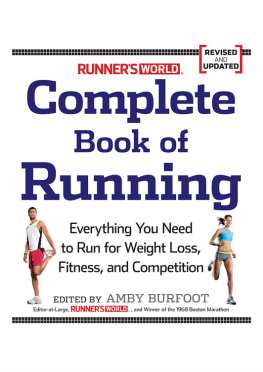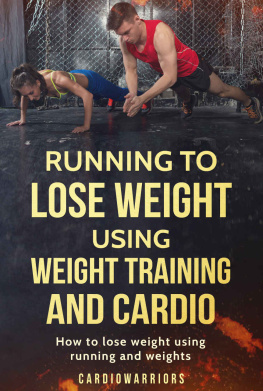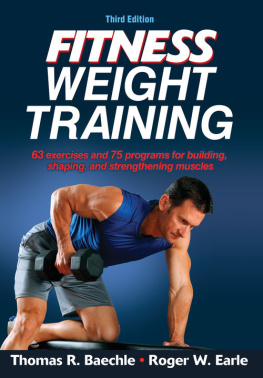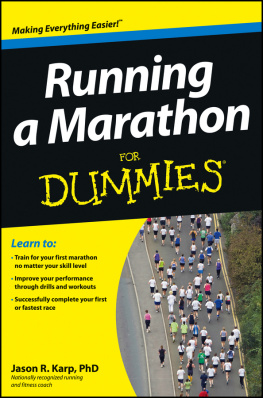WEIGHT
TRAINING
for
RUNNING
The Ultimate Guide
Weight Training for Running The Ultimate Guide
Copyright 2012 Robert G. Price
ISBN: 978-1-932549-76-8
eISBN: 978-1-936910-14-4
Library of Congress Control Number: 2011938369
Prior to beginning any exercise program, you must consult with your physician. You must also consult your physician before increasing the intensity of your training.
Any application of the recommended material in this book is at the sole risk of the reader, and at the readers discretion. Responsibility of any injuries or other negative effects resulting from the application of any of the information provided within this book is expressly disclaimed.
All rights reserved. Neither this book, nor any parts within it may be sold or reproduced in any form without permission.
Published by Price World Publishing
1300 W. Belmont Ave. Suite #20g
Chicago, IL 60657
Interior photographs by Marc Gollub
Editing by Barb Greenberg
Editing and proofreading by Maryanne Haselow-Dulin
For information about discounts for bulk purchases, please contact
.
Printing by
10 9 8 7 6 5 4 3 2 1

WEIGHT
TRAINING
for
RUNNING
The Ultimate Guide
Robert G. Price CPT

CONTENTS

Part I
RUNNING
Specific
Training

With Weight
Training,
KNOWLEDGE
IS THE KEY
TO SUCCESS
INTRODUCTION
By opening Weight Training for Running, you have taken your first step towards achieving your athletic potential. This book is loaded with the most up-to-date sports weight-training information and features a year-round running-specific weight-training program. Upon completion of the text, you will know how to properly, safely, and effectively perform over 80 exercises and you will be ready to begin your training.
The most important part of this book is the running-specific weight- training program itself, which begins on page 6. This program was created for one reason and one reason only: to improve your running potential. It does this by increasing your strength, endurance, and flexibility in the parts of your body that are most important for running. This program was designed to supply you with the advantage you will need to outperform your opponents. By following this program, you will build your muscles with endurance and stamina. When called upon, you will be physically prepared and mentally ready to compete at the highest of your potential.
Although running is primarily a sport focusing on leg strength and endurance, certain upper-body muscle groups should not be ignored in order to achieve your maximum potential. This book does not overlook the importance of these muscle groups and has you training your entire body ignore.
This book does not teach you how to perform specific movements. It does not show you the best strategies to perfect your running technique, nor does it give you any tips to improve your specific running skills. This book does, however, provide you with the best methods, programs, and strategies available to physically improve your body and maximize your running potential.
OFF-SEASON TRAINING
The off-season is the time in any sport to build up your muscles, become more powerful, and increase muscular endurance. The off-season program consists of four 4-week routines cycled together to maximize both muscular endurance and explosive-power. The first and third routines are designed to build your stamina and muscular endurance, while the second and fourth routines are designed more for power and explosion.
Variation is very important to an effective workout program. Varying your routines keeps you making progress and gains. Your body eventually will adapt to any routine its on, so it is very important to change routines once your gains have stopped and your strength has peaked. Changing programs every four-weeks is the most effective time period to follow any one routine. For more information on the importance of variation to weight training, see the section The Declaration of Variation.
During the off-season, you must supplement your weight-training activities with some sort of running-specific activities to keep your body in proper shape.
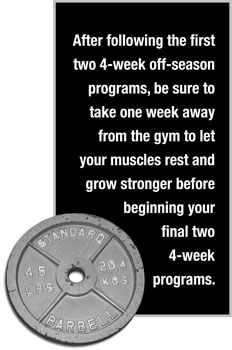
MUSCULAR ENDURANCE TRAINING
The first and third routines of the off-season cycle are to enhance your muscular endurance. Weight-training for muscular endurance differs greatly from strength and power training. Strength training builds up size, bulk, and strength; power training builds explosion, speed, and intensity; and endurance training builds your stamina by enabling your muscles to work longer without fatiguing. Weight-training to increase your muscular endurance requires many slow movement repetitions to train and build your slow-twitch muscle fibers, which are responsible for increased endurance and stamina.
The keys to endurance training are as follows:
Low weight, high reps:
Proper endurance training calls for lifting light weights many times. Weights that are less than 60% of your one-rep max are ideal. With more repetitions comes increased muscular endurance, or the ability of your muscles to operate at a high level over time. Every additional repetition helps to increase your muscular endurance. Typically, sets involving at least 20 repetitions are considered to be training your muscular endurance.
Proper breathing:
Breathing properly is extremely important in endurance training. As you perform repetition after repetition, your instincts will be to hold your breath. With each and every rep, be sure to inhale while lowering the weight on the eccentric movement and exhale while raising the weights on the concentric movement. Never hold your breath.
Smooth rhythmic lifts:

